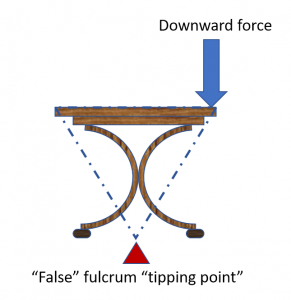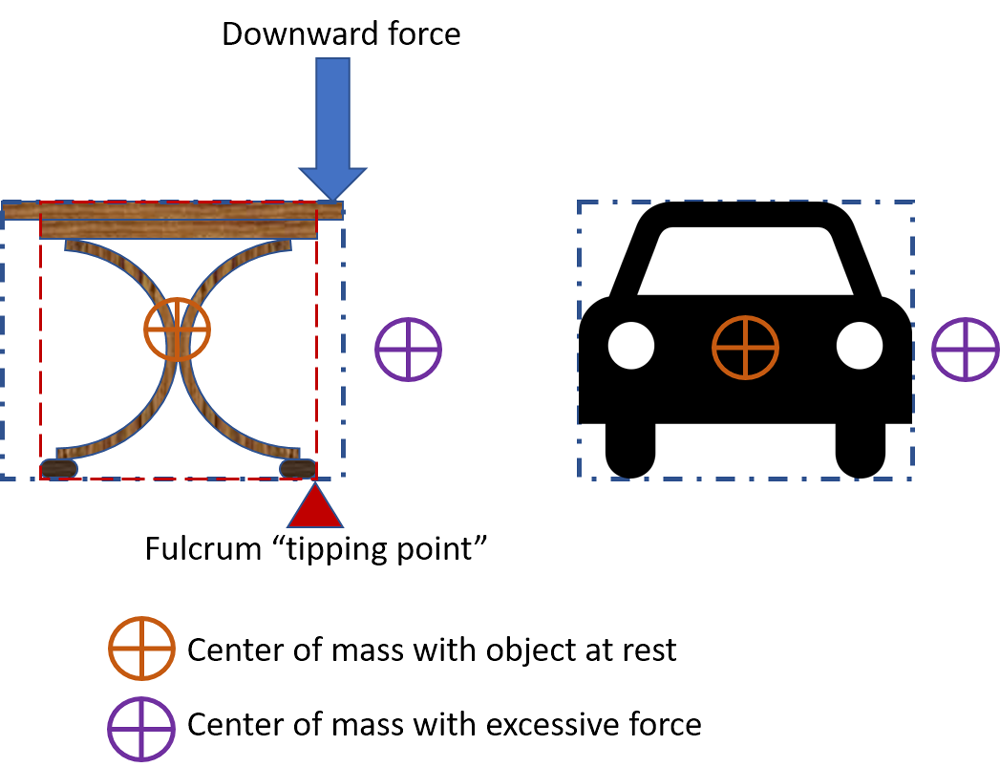One of the questions that I have been asked numerous times over the years is, “Did your theatre background actually help in ‘everyday’ life?”
Well, I guess you could call it one of the benefits of a liberal arts education, but, yes, my theatre background has helped, and continues to help, all the time in “regular” life.
A prime example is what I call “practical physics”. What is practical physics? Let me give you an example.
Many years ago, I was working on a show (It might have been “See How They Run”, but I don’t actually remember) and the director wanted a piece of business on stage that was absolutely not working. Two actors were supposed to be in a fight. There was a pistol involved, somehow, and at one point the performers were to end up rolling around on the floor.
The director wanted one actor to do a stage fall and land a forearm on the edge of a table. The table was then supposed to tip over. The problem is that there was a miss-understanding of the physics of the situation. At the same time, there is a miss-understanding of what causes an automobile to tip over. Tables? Cars? Miss-understandings?

In the diagram to the right, we see a basic illustration of the table in question and a simple car. Although their comparative sizes are wildly miss-matched, we see that the basic shapes are identical. Both are rectangles.
The miss-understanding regarding the table stems from the curved legs. Although it is obvious in the diagram, in real life the thin legs and their curved shape give the impression that the table could easily tip over if a downward force was applied to the edge of the table-top. In fact, the force required to tip the table would be tremendous and probably break the table.

The basic shape of the table is a rectangle, or a box. A downward force on the top of a box will not result in tipping. However, if the basic shape of the table was a triangle, with the point down, the table would easily tip. The point would be a fulcrum, let’s call it a “tipping point”, and, as you might guess, it could probably fall over on its own. The diagram on the right illustrates this idea.
This is a miss-understanding of the actual shape of the table. I wouldn’t be surprised to discover that the table’s designers intended for this very effect. Although the table is light weight and appears airy, so to speak, it is quite strong and solid. The weak point in the structure is the point where the legs join. But, that is a mechanical and carpentry issue.
An automobile is more like a table than one would imagine. The basic shape is also a rectangle. It is a sort of rolling box. As it turns out, automobile designers refer to cars as being one box or two box body styles. Cars are, relatively speaking, much like tables in that they are very hard to turn over unless a large force is applied.
Unlike tables, automobiles come with their own force, their engines, and with enough power and speed a car will flip. The table that the director to have turn over did not have internal power, and the force had to be applied externally by the actor.
To get an object, table, car, whatever, to flip over requires applying enough force to move the center of mass outside of the box shape. In the diagram below, we see that that the table has what I call an “inside box”, shown in red, and an “outside box”, shown in blue. The falling actor would have had to collide with the table top inside the small distance between the red and blue outlines. If he dropped onto the table inside the red outline, nothing would happen.

The target area, the space between the red and blue outlines, is very small and functions as a sort of short lever. But, it is too short of a lever to cause the center of mass to move from the middle of the red box to the outside of the blue box. Unless that center of mass moves outside of the blue outline, nothing will happen.
We also see that the automobile also has a similar box outline. It also has a center of mass. To get the car to tip, as with the table, it is necessary to get the center of mass outside of the blue outline.
Whereas the table requires an outside force, such as the falling actor, the car requires internal force as supplied by the engine and a curved path such as you get when rounding a corner. That force causes the center of mass to move outside of the box and the car should tip. The farther the center of mass moves out, the more likely the car is to tip quickly.
Now, when we get into the automotive dynamics we discover that there are lots of variable factors. There are considerations such as speed, the radius of the curve, and the bank of the roadway. Comparatively speaking, any change to one of those factors will change how and when the car will tip.
The table does not really have any variable factors, except the falling force of the actor.
While the director wanted the table to tip, generally speaking, the car driver wants the vehicle to stay upright. Understanding of the principles of practical physics makes sure that both actions happen, or not, as required. We see, then, that there are a lot of similarities between stage business and auto dynamics. If you understand one, you should understand the other.
Nothing like every day practical physics.
Oh, by the way, the solution to the tipping table was rather obvious. The director never could get the table to tip over when the actor fell on it. The table actually cracked and had to be repaired. I came up with an alternative bit of business. We had the actor do a stage fall and roll partially under the table, then he came up to a sitting position. On the way up, he “hooked” the table with an arm and lifted the table’s edge so that it rolled over. It worked nicely, and the director got the effect needed.